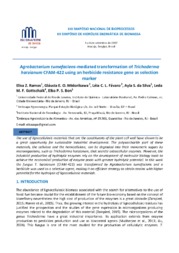Agrobacterium tumefaciens-mediated transformation of Trichoderma harzianum CFAM-422 using an herbicide resistance gene as selection marker.
Agrobacterium tumefaciens-mediated transformation of Trichoderma harzianum CFAM-422 using an herbicide resistance gene as selection marker.
Author(s): RAMOS, E. Z.; MIDORIKAWA, G. E. O.; FAVARO, L. C. de L.; SILVA, A. S. da; GOTTSCHALK, L. M. F.; BON, E. P. S.
Summary: The use of lignocellulosic materials that are the constituents of the plant cell wall have shown to be a great opportunity for sustainable industrial development. The polysaccharide part of these materials, the cellulose and the hemicellulose, can be degraded into their monomeric sugars by microorganisms, such as Trichoderma harzianum, that secrete extracellular enzymes. However, the industrial production of hydrolytic enzymes rely on the development of molecular biology tools to achieve the economical production of enzyme pools with greater hydrolytic potential. In this work the fungus T. harzianum (CFAM-422) was transformed by Agrobacterium tumefaciens and a herbicide was used as a selective agent, making it an efficient strategy to obtain strains with higher potential for the hydrolysis of lignocellulosic materials.
Publication year: 2017
Types of publication: Paper in annals and proceedings
Unit: Embrapa Food Technology
Observation
Some of Embrapa's publications are published as ePub files. To read them, use or download one of the following free software options to your computer or mobile device. Android: Google Play Books; IOS: iBooks; Windows and Linux: Calibre.
Access other publications
Access the Agricultural Research Database (BDPA) to consult Embrapa's full library collection and records.
Visit Embrapa Bookstore to purchase books and other publications sold by Embrapa.

